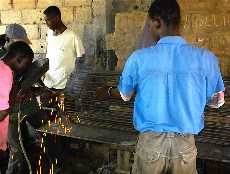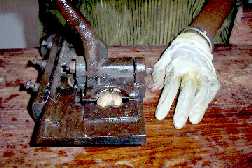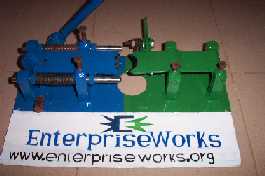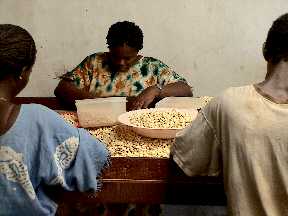Summary
How to order cashews from West Africa
How the nuts are shelled and processed
Technologies used
Who is producing the cashews
Email EnterpriseWorks
Call us at
(221) 991 4733
|
|
Technologies for processing cashews
exist on different scales - huge mechanized plants used mostly in Brazil,
smaller manual technologies imported from India, etc. EnterpriseWorks
chooses to promote manually-operated machines that are manufactured in
the country where the processing takes place. The manual technologies
turn out to give the best value for the output, and their use results in
the employment of large numbers of workers in Africa. Manufacturing the
technologies within the country where they are used means a steady supply
of new machines and their spare parts, as well as mechanics qualified
to make repairs.
EnterpriseWorks has a range
of cashew technologies gathered from various sources, and our technicians
have re-engineered many of them to be more effective, cheaper, and capable
of being made out of the materials found locally. We train privately-owned
shops to make and sell the machines, which creates employment
for metalworkers. The fact that local shops supply
the equipment means that their livelihoods depend on the business they
do among themselves, and is in no way reliant on the project.
|

|
The first step in processing
is sorting the raw nuts, for which a simple revolving sorter is used
to separate large nuts from small
|

|
Next comes steaming. There
are small, very inexpensive steamers made from steel barrels. For
larger enterprises there are autoclaves with a system of steam injection.
|


|
|
After steaming comes shelling. There
are two main models of shellers known as the Brazilian, which is operated
using a pedal and a handle, and the Indian, which has only a handle. Their
blades are specially shaped like the outside of the cashew shell, and
can be easily removed and replaced when dull.
|
 The "Brazilian" sheller
The "Brazilian" sheller
 The "Indian" sheller
The "Indian" sheller
|
Following shelling, the kernels
need to be dried in special ovens. The number of ovens is dependent
on the capacity of the enterprise, as is the fuel source. In most
cases biomass is used as fuel.
|
|
The next two steps are purely
manual - a small, sharp tool is used to scrape the dried interior skin
off the kernels. Then the nuts are sorted by size and quality before
packaging.
|

|
The type of packaging depends
on where the kernels are headed for sale. In the case of immediate
retail sales, the packages are small heat-sealed plastic ones with labels.
|
|
In the case of large bulk shipments,
cashew factories usually use imported packaging machines such as this
Spanish model, which cost over 5,000 euros. EnterpriseWorks is working to
develop a locally-made model that will similarly create a vacuum, inject
nitrogen or CO2 gas to prevent spoilage, and heat-seal large
bags that are then packed in cardboard boxes.
|
|
|
|
|